Introduction
Recognizing the early signs of Autism Spectrum Disorder (ASD) is pivotal for ensuring timely interventions that can significantly enhance a child's developmental trajectory. This article explores the various indicators of autism in infants and toddlers, such as challenges in communication, social interactions, and repetitive behaviors. By understanding these signs, parents can better advocate for their children and seek appropriate professional evaluations.
Early intervention, particularly through developmental and naturalistic developmental behavioral strategies, has been shown to markedly improve social communication and adaptive behaviors, leading to more favorable long-term outcomes. The article also delves into the role of innovative technologies in early detection, the comprehensive evaluation process, and the importance of personalized intervention plans. Empowering parents with knowledge and resources is essential for navigating the complexities of autism and ensuring the well-being of their children.
Understanding Early Signs of Autism
Recognizing early signs of autism is essential for timely intervention and can lead to significant improvements in a young person's development. Autism Spectrum Disorder (ASD) manifests through various behaviors, and understanding these signs can help parents better comprehend their offspring's unique needs. Early indicators often include challenges in communication, social interactions, and repetitive behaviors. For instance, a child might have difficulty engaging in typical back-and-forth conversations, exhibit limited eye contact, or display repetitive movements like hand-flapping.
Research suggests that prompt action, especially developmental and naturalistic developmental behavioral approaches, can significantly improve social communication and adaptive behaviors, promoting better long-term results. Pediatricians are frequently the first to direct families towards these actions, which can be vital during the initial neurodevelopmental phase when the effect of intervention is most significant.
Furthermore, technological progress, such as the application of AI in examining retinal images of youngsters, is demonstrating potential in the prompt identification of autism, providing a non-invasive approach to recognizing possible cases. This innovation, tested on nearly 1,000 young individuals, underscores the importance of utilizing cutting-edge technology to support early diagnosis.
It's important to remember that not all children with ASD will exhibit the same behaviors, and some may not display any of the common signs. Thus, personalized assessment and support plans are essential. Postponed identification can lead to missed chances for timely action, which is why noticing and tackling these initial signs swiftly is so essential.
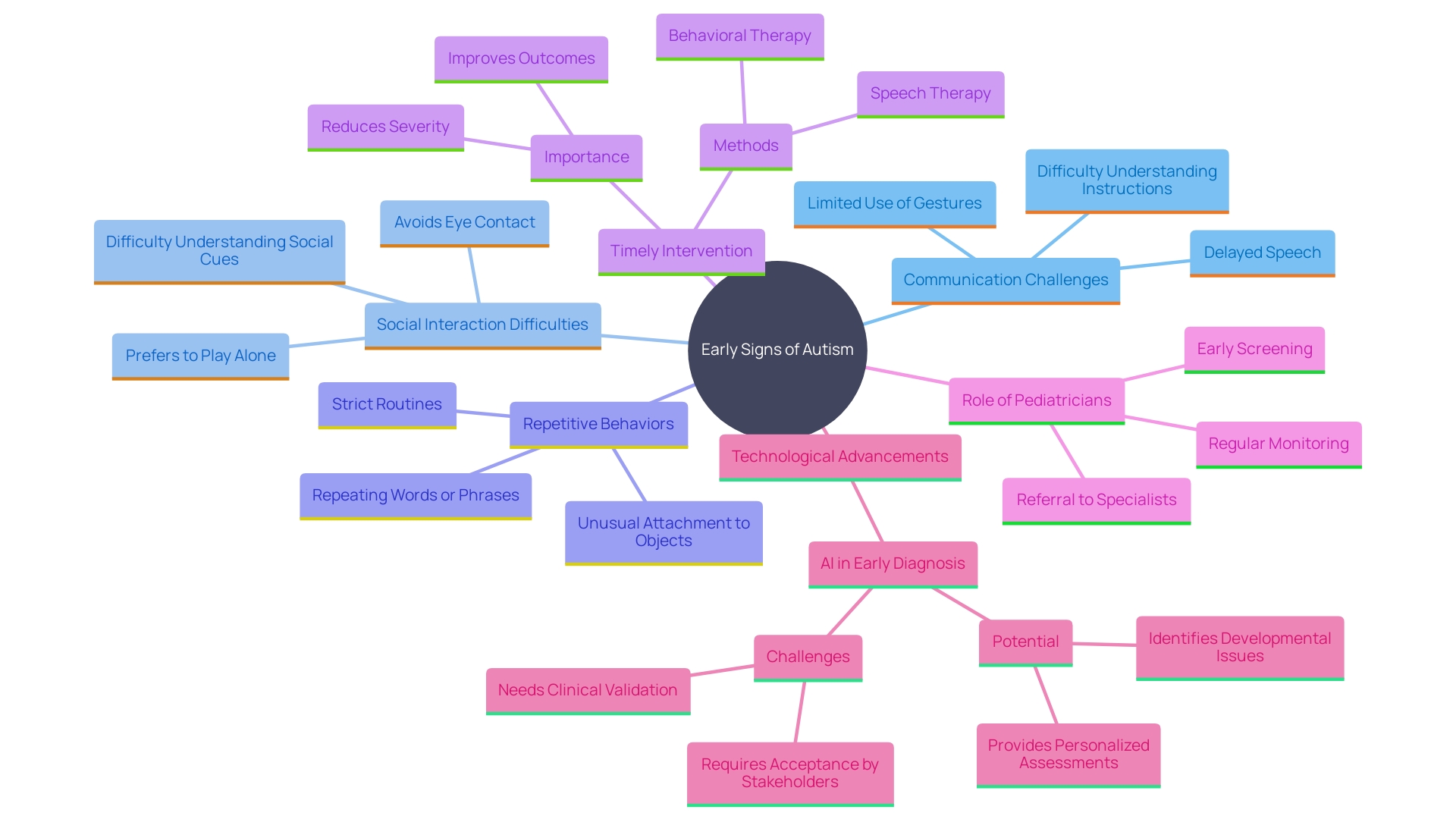
Common Signs of Autism in Babies and Toddlers
In infants and young children, identifying initial signs of autism can be essential for prompt intervention. Parents might observe a lack of eye contact, delayed speech development, or limited interest in social games. Some children may also show unusual reactions to sensory experiences, such as being overly sensitive to sounds or textures. These initial indicators can be subtle yet significant. Comprehending these typical indicators can assist in prompt identification and assistance, which is crucial as initial developmental measures have been proven to enhance social interaction with caregivers. Pediatricians and other doctors frequently suggest intensive behavioral programs, which focus on targeting functional skills, to aid the development of young individuals with autism. Although the kinds of initial childhood support differ greatly in approach and intensity, evidence indicates that naturalistic developmental behavioral strategies effectively enhance core challenges linked to autism, especially difficulties in social communication. Therefore, recognizing these early signs and seeking professional evaluation can lead to beneficial early interventions, promoting positive long-term outcomes for individuals with autism.
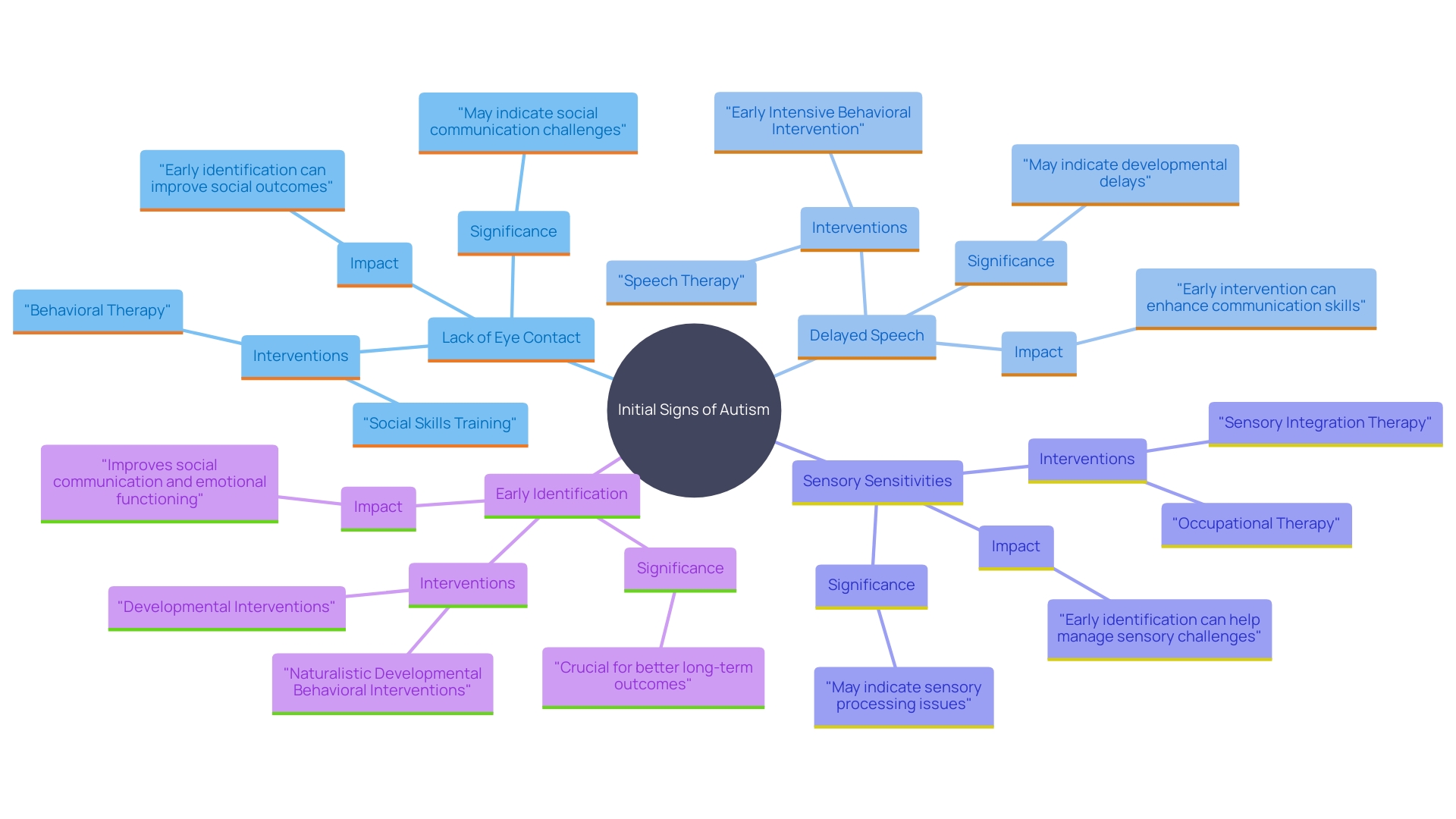
Signs of Autism in 1-Year-Olds
By the time youngsters reach one year of age, certain signs may start to become noticeable. These signs might include a lack of babbling or gestures, minimal response when their name is called, and limited interest in playing with others. Observing these behaviors can offer parents essential understanding of their offspring's developmental progress and possible challenges. It is important to understand that children with Autism Spectrum Disorder (ASD) may not exhibit all or any of these behaviors. Developmental delays can suggest a spectrum disorder, but they can also be associated with other underlying conditions such as hearing or vision problems. Prompt action is crucial; research indicates that developmental support can greatly enhance social communication and other fundamental difficulties related to the condition. Pediatricians frequently serve as the initial source of direction for families regarding these measures, emphasizing the significance of prompt and customized assistance.
Importance of Early Intervention
Timely assistance is vital for youngsters with autism, greatly enhancing their long-term results. By initiating support and resources early on, young individuals can develop better communication skills, social interactions, and overall growth. Evidence demonstrates that responsive and engaging parent–offspring interactions are associated with positive outcomes for autistic individuals. Developmental strategies, particularly naturalistic developmental behavioral approaches, have been shown to enhance core challenges associated with autism, especially social communication difficulties.
Parents are crucial supporters for their offspring, ensuring they receive appropriate assistance as soon as possible. Based on studies, prompt actions customized for young individuals' social communication difficulties are more effective. For example, a randomized controlled trial led by Dr. Patricia Muller concentrates on assessing the effects of early measures on parent-child interactions and child outcomes. Such studies emphasize the significance of providing practitioners with the knowledge and skills to execute these strategies effectively.
Furthermore, a recent examination by Micheal Sandbank, PhD, highlights the necessity for clear communication with families about the possible advantages and risks of different approaches. 'Although initial intensive behavioral methods are strongly advised in the U.S., alternative strategies such as pediatric communication therapy and JASPER in the U.K. also demonstrate encouraging outcomes.'. These measures are created to be developmentally suitable and family-empowering, tackling the fundamental social challenges of the condition.
Parents should be informed and supported in their advocacy efforts to ensure their offspring access the best possible early intervention strategies, as these significantly impact their development and quality of life.
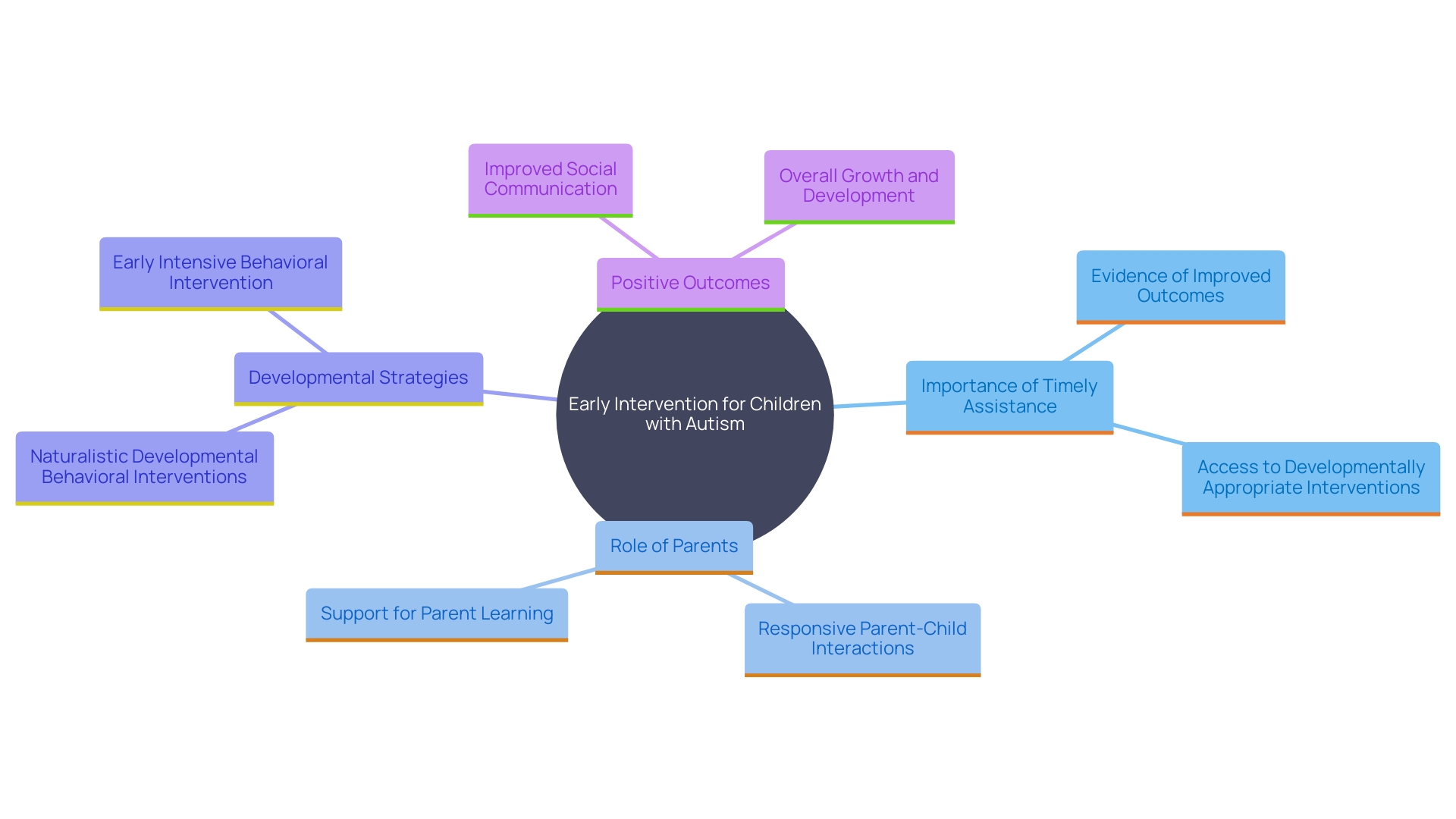
Types of Autism Screening Tools
Various screening tools are available to help parents and professionals evaluate the likelihood of autism in young individuals. These tools often include questionnaires and observational checklists that assess a young person's behavior and development. According to the US Preventive Services Task Force (USPSTF), the evidence is currently insufficient to fully assess the balance of benefits and harms of screening for speech and language delays or disorders in minors without signs or symptoms. Nevertheless, prompt support is vital for young individuals with autism to encourage skill development and favorable long-term results. For instance, early intensive behavioral support in the U.S. emphasizes functional abilities and runs at a level of 20-40 hours each week, whereas in England, lower intensity programs such as pediatric communication therapy for children with developmental disorders are suggested. Becoming acquainted with these screening options and comprehending the evidence backing various interventions can enable parents to take proactive measures in their assessment and support their development effectively.

Comprehensive Evaluation Process
If initial screenings suggest the possibility of autism, a comprehensive evaluation by a multidisciplinary team of specialists is essential. This group usually consists of experts such as developmental pediatricians, psychologists for youth, speech and language therapists, and occupational therapists. They collaborate to evaluate different facets of a young one's development, concentrating on cognitive, communication, and social skills. Grasping this process can greatly assist parents in feeling more ready and engaged in their offspring's evaluation.
The evaluation process can be intensive and requires the dedication of time and resources from families. Families often face substantial stress due to the complexities of Autism Spectrum Disorder (ASD), which may include financial strain, anxiety about the individual's future, and the need for extensive social support. Evidence shows that social and peer support, along with hope, are key strategies to alleviate family distress, promoting emotional support and information exchange.
The significance of prompt action cannot be emphasized enough. Studies suggest that timely, developmentally suitable measures customized to the individual requirements of young individuals facing social communication difficulties are essential. These actions can greatly enhance the child's social communication skills, adaptive behavior, and overall development.
However, obtaining timely assessments and actions can be a challenge. Research shows that around two-thirds of specialty care facilities experience wait periods exceeding four months for evaluations related to developmental disorders, with certain waitlists lasting more than a year. This delay can prevent young individuals from receiving essential early intervention during the most significant period of neurodevelopment. Additionally, the lack of standardized care and reimbursement barriers further complicates access to necessary services, particularly for disadvantaged families.
'Parents' accounts of their offspring's growth and professional assessments of the young one's behavior constitute the foundation of this diagnosis. The DSM-5 provides standardized criteria to aid in diagnosing ASD, but no single tool should be solely relied upon. Often, primary care providers may refer families to specialists for further assessment to ensure a comprehensive and accurate diagnosis.
By understanding the comprehensive evaluation process and the challenges involved, parents can better navigate the journey towards securing the best possible care and support for their offspring.

Diagnostic Instruments for Autism
Several diagnostic instruments are utilized to confirm a diagnosis of autism, each serving a unique role in the evaluation process. Central to this are structured interviews and standardized assessments, which often draw upon the American Psychiatric Association's Diagnostic and Statistical Manual, Fifth Edition (DSM-5) criteria. These tools are designed to capture detailed descriptions from parents or caregivers about their offspring's development, coupled with a professional's direct observation of the young one's behavior.
In practice, these diagnostic tools typically rely on two main sources of information: the developmental history provided by parents or caregivers and the clinician's observation of the individual's interactions and behaviors. This dual approach ensures that the diagnosis is comprehensive and considers both subjective and objective data. For instance, the Autism Diagnostic Interview-Revised (ADI-R) and the Autism Diagnostic Observation Schedule (ADOS) are widely recognized instruments used in clinical settings to evaluate the condition.
In some cases, primary care providers might refer families to specialists for further evaluation. These specialists may include neurodevelopmental pediatricians, developmental-behavioral pediatricians, pediatric neurologists, and geneticists, as well as early intervention programs that offer specialized assessment services. Comprehending these diagnostic instruments and procedures enables parents by offering clarity on how experts assess the condition and the standards they apply for a diagnosis, promoting a more knowledgeable and supportive strategy for their child's care.
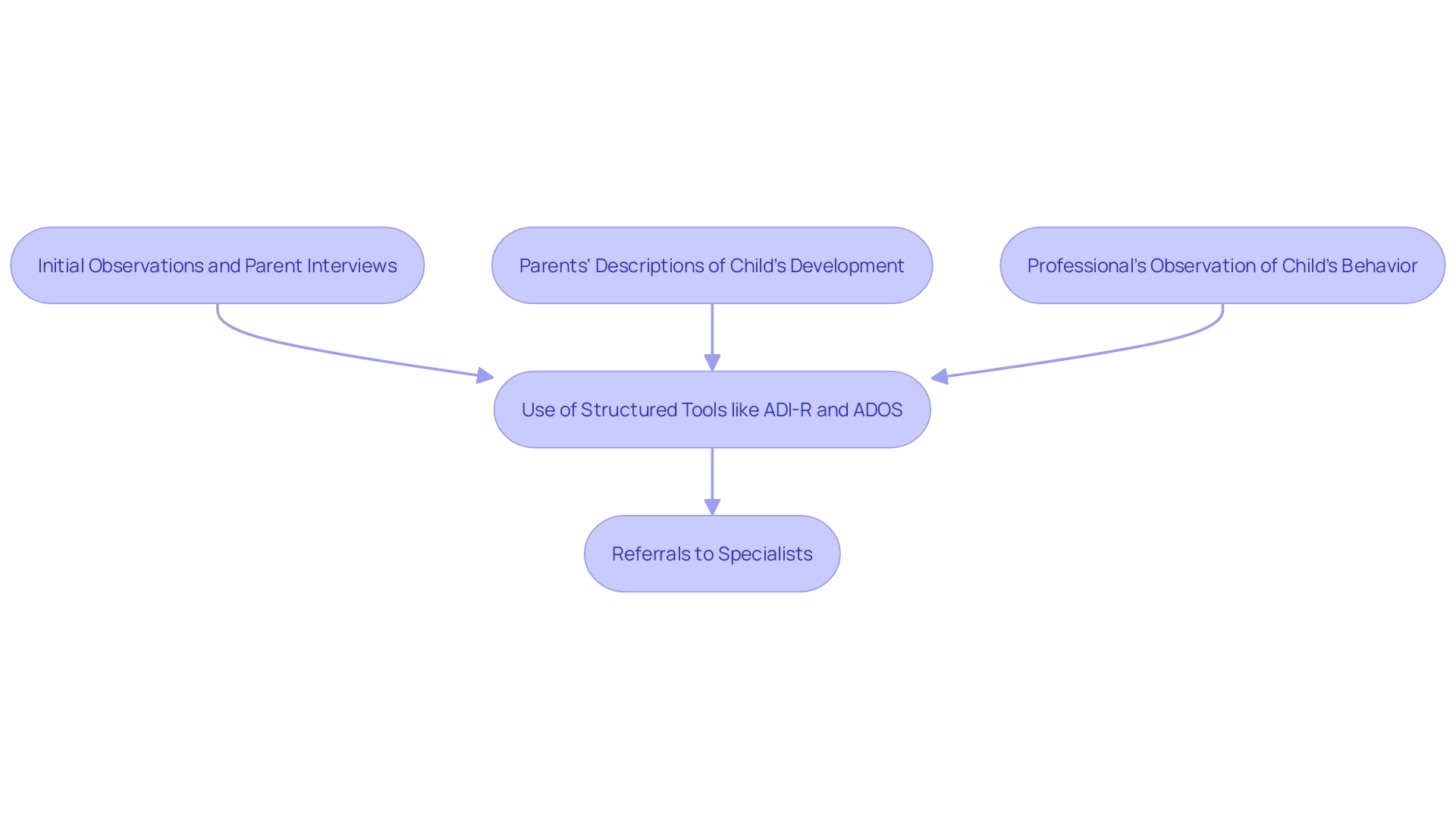
Next Steps After Screening
'After finishing a screening for developmental differences, parents might experience a range of emotions, from relief to uncertainty.'. It's essential to understand the subsequent steps, which may involve further assessments or consultations with specialists. Creating a plan for ongoing support and resources is crucial in this journey. Evidence shows that families dealing with autism often face significant stress due to financial burdens, anxiety about the future, and social isolation. However, strategies like social support, peer support, and fostering hope can significantly alleviate this distress. Real-world studies have demonstrated that even low-intensity programs involving both parents and clinicians can yield substantial benefits. Parents who participate in these programs often feel more capable of supporting their offspring's development and managing their unique needs. This holistic approach not only enhances the child's engagement and communication but also strengthens the family's overall wellbeing.
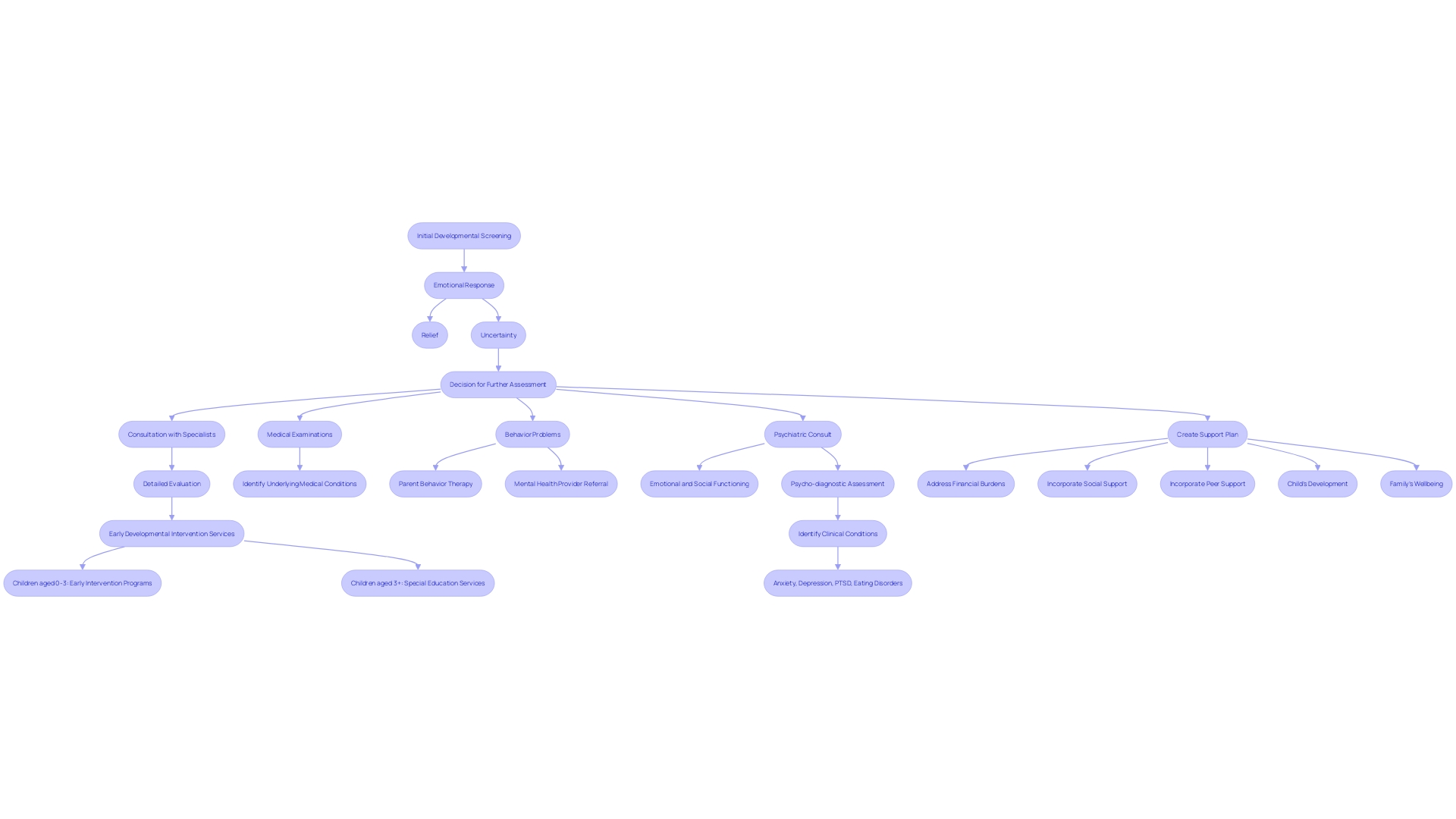
Conclusion
Recognizing the early signs of Autism Spectrum Disorder (ASD) is crucial for facilitating timely interventions that can significantly enhance a child's developmental journey. The article highlights key indicators such as challenges in communication, social interactions, and repetitive behaviors, underscoring that early detection can lead to more effective support. The importance of utilizing innovative technologies and comprehensive evaluation processes is emphasized, equipping parents with the knowledge to advocate for their children effectively.
Early intervention plays a pivotal role in improving long-term outcomes for children with autism. The evidence presented illustrates that developmental and naturalistic behavioral strategies can foster better communication and social skills, directly impacting a child's growth. As parents navigate this complex landscape, understanding the variety of screening tools and the comprehensive evaluation process is essential.
This knowledge empowers them to take proactive steps in securing the necessary support and resources for their children.
In summary, the journey towards understanding and addressing autism requires a collaborative effort between parents, healthcare providers, and specialists. By recognizing early signs, pursuing timely evaluations, and advocating for appropriate interventions, parents can significantly contribute to their child's development and overall well-being. The commitment to early intervention not only benefits the child but also strengthens family resilience, fostering a supportive environment for growth and success.




